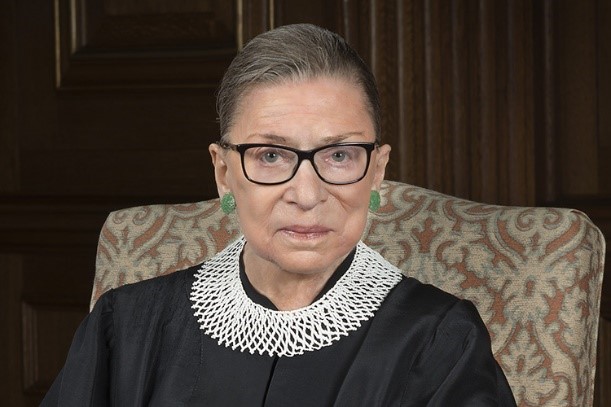
"Real change, enduring change, happens one step at a time."
"You can disagree without being disagreeable."
"So often in life, things that you regard as an impediment turn out to be great, good fortune."
Ruth Bader Ginsburg became the second female justice of the U.S. Supreme Court. Born in 1933 in Brooklyn, New York, Bader taught at Rutgers University Law School and then at Columbia University, where she became its first female tenured professor. She served as the director of the Women’s Rights Project of the American Civil Liberties Union during the 1970s, and was appointed to the U.S. Court of Appeals for the District of Columbia in 1980. Named to the U.S. Supreme Court in 1993 by President Bill Clinton, she continued to argue for gender equality in such cases as United States v. Virginia. She died September 18, 2020 due to complications from metastatic pancreas cancer.
Early Life
Ruth Joan Bader, the second daughter of Nathan and Cecelia Bader grew up in a low-income, working class neighbourhood in Brooklyn, New York. Ginsburg's family was Jewish. Ginsburg’s mother, a major influence in her life, taught her the value of independence and a good education.
Cecelia herself did not attend college, but instead worked in a garment factory to help pay for her brother’s college education, an act of selflessness that forever impressed Ginsburg. At James Madison High School in Brooklyn, Ginsburg worked diligently and excelled in her studies. Her mother struggled with cancer throughout Ginsburg’s high school years, and died the day before Ginsburg’s graduation.
Bader graduated from Cornell University in 1954, finishing first in her class. She married Martin D. Ginsburg, also a law student, that same year.
The early years of their marriage were challenging, as their first child, Jane, was born shortly after Martin was drafted into the military in 1954. He served for two years and, after his discharge, the couple returned to Harvard where Ginsburg also enrolled.
At Harvard, Ginsburg learned to balance life as a mother and her new role as a law student. She also encountered a very male-dominated, hostile environment, with only eight females in her class of 500.
The women were chided by the law school’s dean for taking the places of qualified males. But Ginsburg pressed on and excelled academically, eventually becoming the first female member of the prestigious legal journal, the Harvard Law Review.
Arguing for Gender Equality
Then, another challenge: Martin contracted testicular cancer in 1956, requiring intensive treatment and rehabilitation. Ginsburg attended to her young daughter and convalescing husband, taking notes for him in classes while she continued her own law studies.
Martin recovered, graduated from law school, and accepted a position at a New York law firm. Ginsburg transferred to Columbia Law School in New York City to join her husband, where she was elected to the school’s law review. She graduated first in her class in 1959.
Despite her outstanding academic record, however, Ginsburg continued to encounter gender discrimination while seeking employment after graduation. After clerking for U.S. District Judge Edmund L. Palmieri, she taught at Rutgers University Law School (1963-72) and at Columbia (1972-80), where she became the school’s first female tenured professor.
During the 1970s, she also served as the director of the Women’s Rights Project of the American Civil Liberties Union (ACLU), for which she argued six landmark cases on gender equality before the U.S. Supreme Court.
However, she also believed that the law was gender-blind and all groups were entitled to equal rights. One of the five cases she won before the Supreme Court involved a portion of the Social Security Act that favoured women over men because it granted certain benefits to widows but not widowers.
On the Supreme Court
In 1980, President Jimmy Carter appointed Ruth Bader Ginsburg to the U.S. Court of Appeals for the District of Columbia. She served there until she was appointed to the U.S. Supreme Court in 1993 by President Bill Clinton, selected to fill the seat vacated by Justice Byron White.
President Clinton wanted a replacement with the intellect and political skills to deal with the more conservative members of the Court. The Senate Judiciary Committee hearings were unusually friendly, despite frustration expressed by some senators over Ginsburg’s evasive answers to hypothetical situations.
Several expressed concerned over how she could transition from social advocate to Supreme Court Justice. In the end, she was easily confirmed by the Senate, 96-3. Ginsburg became the court's second female justice as well as the first Jewish female justice.
As a judge, Ginsburg was considered part of the Supreme Court’s moderate-liberal bloc, presenting a strong voice in favour of gender equality, the rights of workers and the separation of church and state.
In 1996, Ginsburg wrote the Supreme Court’s landmark decision in United States v. Virginia, which held that the state-supported Virginia Military Institute could not refuse to admit women. In 1999, she won the American Bar Association’s Thurgood Marshall Award for her contributions to gender equality and civil rights.
Legacy
Despite her reputation for restrained writing, she gathered considerable attention for her dissenting opinion in the case of Bush v. Gore, which effectively decided the 2000 presidential election between George W. Bush and Al Gore.
Objecting to the court’s majority opinion favouring Bush, Ginsburg deliberately and subtly concluded her decision with the words, “I dissent” a significant departure from the tradition of including the adverb “respectfully.”
On June 27, 2010, Ruth Bader Ginsburg’s husband, Martin, died of cancer. She described Martin as her biggest booster and “the only young man I dated who cared that I had a brain.”
Married for 56 years, as a couple, they were said to be quite different: Martin was gregarious, loved to entertain and tell jokes while Ruth was serious, soft-spoken and shy. Martin provided a reason for their successful union: “My wife doesn’t give me any advice about cooking and I don’t give her any advice about the law.”
